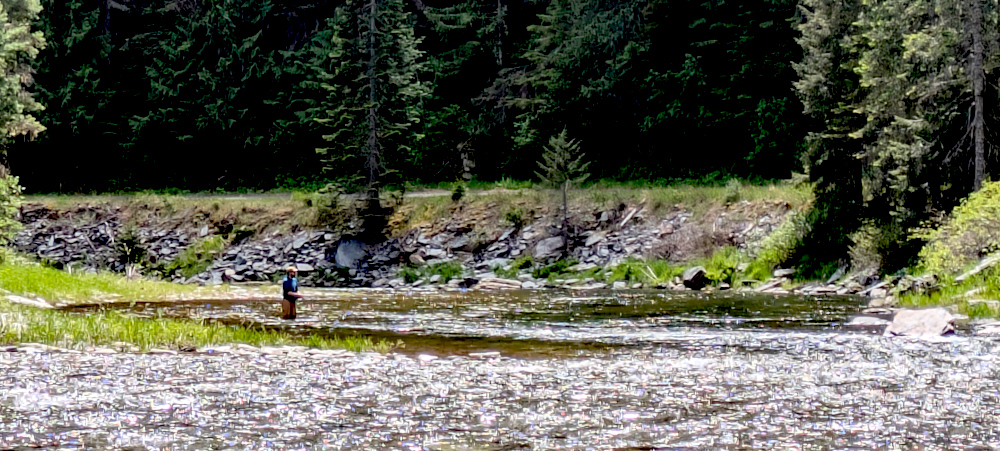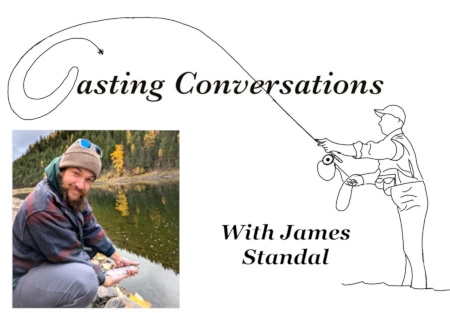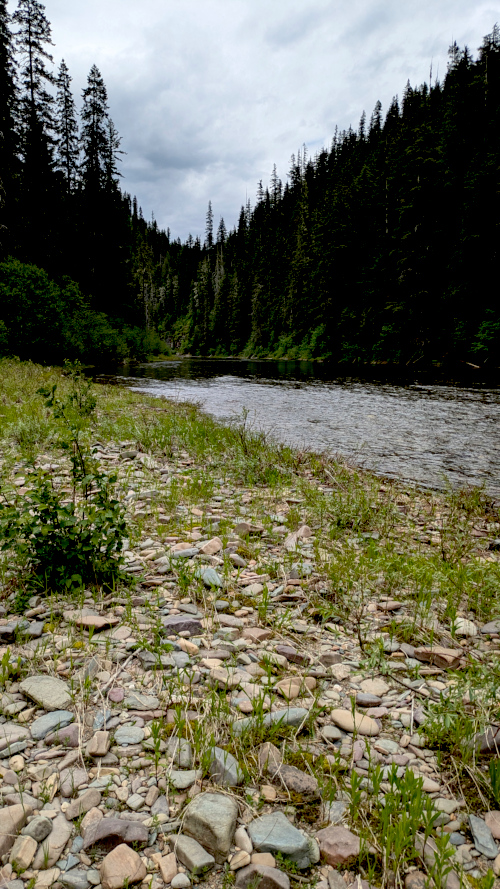
 Finally, my feet are in my wading shoes a few feet under the gin-clear waters of the North Fork of the Coeur d’Alene where the water is still flowing quick yet the cutthroat are rising to the surface at a great pace. It has been a rough week of late springtime blues throughout the household, a wild toddler at home, high and fast runoff rivers and streams, all wrapped around a tight wad of rapidly increasing temperatures. But as Jim Harrison once wrote, “Few of us shoot ourselves during an evening hatch.”
Finally, my feet are in my wading shoes a few feet under the gin-clear waters of the North Fork of the Coeur d’Alene where the water is still flowing quick yet the cutthroat are rising to the surface at a great pace. It has been a rough week of late springtime blues throughout the household, a wild toddler at home, high and fast runoff rivers and streams, all wrapped around a tight wad of rapidly increasing temperatures. But as Jim Harrison once wrote, “Few of us shoot ourselves during an evening hatch.”
Now, it is more midday than evening as the cold water rushes over my ankles and the mountain bluebird sings its charming song among the gangly limbs of a tall lodgepole pine.
Little blue is able to pull itself through the dense cloud cover and a cool westerly breeze keeps me comfortable as I wade knee deep across a wide, fast part of the river towards the south shore of a tried-and-true spot that has produced over years and years of fishing it.
The river provides some of the best opportunities for freestone river fishing in North Idaho (and honestly, the surrounding states) as it pours out of the Bitterroots and meanders over stones of red, white, brown, and orange until it dumps into the Harrison Slough of Lake Coeur d’Alene.
What lurks under these beautiful clear waters are what I consider one of the best (if not the best) fish to catch in this wonderful country of ours: the Westslope Cutthroat Trout.
I arrive at the far bank and lean the stick I used as a wading pole against a small boulder and make my way down to the bottom of a large drift section before it turns into quick, river wide riffles. I sit down to wait, watch, rest and relax.

My wife and my son are gallivanting along the river upstream of me at a distance where I cannot hear them, and I let out a deep sigh of relief. Not that I don’t love hearing their voices and being with them, but I also very much love having time where all I hear is the voice of flowing waters, whispers of the wind rustling branches, and also, nothing.
This is the spot where last fall Les Bevan and I were out fishing and he asked me if I felt better and happier and calmer along the moving waters of a river, to which I replied, “of course.”
He told me about the theory behind negative ions, atoms that have extra electrons, leading to them to have a negative electrical charge. Hypothetically, being around an abundance of negative ions will boost your mood, increase the oxygen flow to your brain, and clear out all the air pollutants in the area.
Now, I do not believe that this has any scientific backing to be an absolute truth; I have seen plenty of angry people on the river. I have been one after one too many tree branch snags and lost flies. But for the most part, I feel like I just enjoy being by the river and everything that it brings for me. I do not need an explanation other than I like water and I like to fish.
After five minutes of watching, I see something emerge from the pool across the seams and main current. Then, another. Another. A hatch had begun–grey caddis, and lots of them. Little ripples caused by little snouts begin to surface and then, some bigger snouts. The hunt was on.
I pull out my fly box and immediately spot the fly of choice for the day, a grey Klinkhammer tied by Leanna Young at The Last Resort in downtown Bonners Ferry. The way the fly is tied (and it is a fun and fairly easy fly to tie) makes it float on or slightly below the surface at a dip that imitates an emerging caddis or mayfly.
Like the Adams fly, it is an imitator of multiple different bugs and an absolute killer for the trout of North Idaho. Yet, the Klinkhammer sometimes finds itself wrapped up in a debate by the fly fishing purists who adhere to the tenet that mastering the presentation of a fly pattern is the most important part of the fly casting and fish catching book that was written by no one.
The philosophy behind a well-presented basic pattern outperforming the most realistic looking fly if presentation is poor is a tale as old as time, and a near truth depending on how one feels that day.
So with the Klinkhammer, a quite realistic pattern that can be very effective even on the worst presentation of it, can be looked down upon as a crutch by the purists like the San Juan Worm is. But as a fly fishing purist will say that a fish caught on any fly other than a dry fly is not a legitimately caught fish, these people are just weird and nitpicky. Fish how you want to fish.
With that said, the Klinkhammer was the correct choice for this situation.
With the first cast, a fish was on. For a seven-inch fish, it put up a good fight. Into the net, I wet my hands and slid my barbless Klinkhammer from the juvenile cutthroat’s lip and slipped it back into the water, thanking him for starting what is to be a great day of fishing on the river.
In the next four casts, four more gorgeous native cutthroat landed in my net, anywhere from seven-to-10 inch. I checked my fly for the condition and things were holding on well (great job, Leanna).
Out of the corner of my eye I see emerging from the fast current a snout, a fin, and a large tail following it as the fish goes back down about twenty feet from where I stand. There it was, the big boy of the hole. I roll a quick cast out far in front of the fish, a smaller fish went for it but missed it in the fast water, and then right where I knew the fish would be, it rises and takes the Klinkhammer and drags it under.
I take a breath, exhale, set the hook, and my five weight bends hard and my Pflueger Medalist 1494 sings its song as if it was one of the bluebirds as the fish makes its run. I palm the reel to try and hold it back just a little and the fish turns this way and that. It starts racing back my way and I strip my line and slap-spin the reel to get the line in as quickly as possible. The fish jumps, and I see the handsome bronze back and smattering of black dots racing down the side of the leviathan.
My heart is racing, my feet are planted. At the peak of its jump, the fish seemingly makes eye contact with me and spits the fly out of its mouth.
I swear it winked at me.
I curse the waters and the trees around me. I curse the fish. I curse to myself about how I blew the opportunity. But I understand that it was not my fish to catch today. We have all lost many fish, big and small (heck, I wrote about missing a big one in last week’s column).
But it still hurts. After many more casts and ten more seven-to-12 inch cutthroat into my net, it is time to meet back up with my family and visit my mother, who recently moved down to Coeur d’Alene.
But as I sit inside Trail’s End Brewing, enjoying their pizza and great selection of beer, all I can think about is that fish I missed and how I wish that my feet were still cold in the waters leaking from the Bitterroots.
Tight lines out there, friends.
For a fishing report this week, the Moyie is still a bit quick but the fishing has been heating up and is quite good (as far as fishing goes in the Moyie). The Kootenai should be a good deal lower than it is right now as of June 7 and will provide some pretty decent fishing as long as you have a watercraft to drift down it. The lakes are, well, the lakes. You should know what to expect. But I suggest that any of you who are fly fishers, or interested in fly fishing, should make it down to the North Fork of the Coeur d’Alene as soon as possible. The fishing is about as good as it gets down there before the waters drop a bit more in the heat of summer. The St. Joe should be clearing up from the runoff and will provide some S tier fly fishing.
